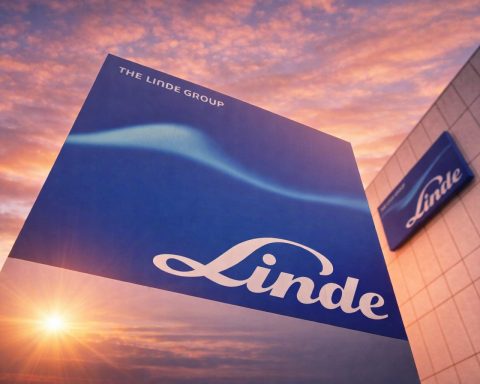- Raised Guidance Propels Stock: American Airlines Group Inc. (NASDAQ: AAL) sharply raised its full-year 2025 profit forecast to an adjusted $0.65–$0.95 EPS, a turnaround from its prior guidance (which ranged from a loss of -$0.20 to a slight profit) [1]. The news sent AAL stock surging ~6% on Thursday, closing at $12.77 on Oct. 23 [2] [3].
- Q3 Earnings Beat Expectations:Third-quarter 2025 revenue hit a record ~$13.7 billion (flat year-on-year) [4], slightly above Wall Street estimates [5]. Adjusted earnings came in at -$0.17 per share, a smaller loss than expected (analysts had projected -$0.28) [6], as cost controls and premium demand helped offset headwinds.
- Pricing Power Returns: After a mid-year travel slowdown, American and other carriers cut capacity to lift fares. By September, unit revenue (passenger revenue per seat) was back to positive growth [7]. American said premium cabin sales remain especially strong, with high-margin luxury fares outperforming main cabin revenue in Q3 [8]. This trend, along with robust holiday travel demand, is restoring pricing power across the industry [9] [10].
- Operational Updates: The carrier announced new strategic moves to bolster profits. It plans to expand premium seating at nearly twice the rate of economy seats and invest in new airport lounges to close the margin gap with rivals Delta and United [11]. American also named Nathaniel “Nat” Pieper (formerly of the oneworld alliance) as its new Chief Commercial Officer effective Nov. 3 [12], tasking him with driving revenue growth.
- Analysts and Forecasts: Wall Street’s consensus on AAL is a “Moderate Buy,” with an average 12-month price target around $16–$17 – roughly 30% above current levels [13]. Optimistic analysts cite American’s improving earnings trajectory and travel rebound, while skeptics warn its $36–$37 billion debt load could pressure margins if fuel prices spike or demand falters [14]. Notably, Goldman Sachs recently reiterated a sell rating with an $8 target, reflecting those debt and cost concerns [15].
- Stock Performance: Even after this week’s rally, AAL shares remain down about 30% year-to-date [16], making it one of 2025’s weaker airline stocks. By comparison, major rivals like Delta Air Lines and United Airlines have fared better on the back of strong profits, while smaller competitor JetBlue has plunged over 40% this year [17]. American’s latest results and guidance upgrade aim to convince investors that its turnaround is gaining altitude, though challenges remain.
Financial Results and Upgraded Outlook
American Airlines reported mixed but encouraging third-quarter 2025 results, turning in record revenue but a small net loss. Total operating revenue reached $13.69 billion, a quarterly record that was flat versus a year ago but slightly above analyst expectations of ~$13.63 billion [18]. The company posted a net loss of $114 million (roughly -$0.17 per share), which was narrower than feared – analysts had predicted a deeper $0.28 per-share loss [19]. This smaller-than-expected loss [20] reflects improved cost management and resilient demand in lucrative segments. In fact, American noted that September turned the corner to positive unit revenue growth, as it successfully pushed fares higher following earlier discounting [21].
On the back of these results, management delivered a positive surprise for investors: American boosted its full-year 2025 profit forecast. The airline now expects $0.65–$0.95 in adjusted earnings per share for 2025, a stark improvement from the previous guidance ranging from a $0.20 loss to $0.80 profit [22]. This implies a solid profit in Q4 and marks a confident outlook that demand and pricing will hold up through year-end. Executives credited industry-wide capacity discipline – airlines deliberately trimmed schedules after a demand dip – for helping restore pricing power and margins [23]. Notably, American’s Q3 adjusted operating margin was about 1.1%, similar to a year ago [24], but the company expects margin expansion going forward as higher fares and internal efficiencies take effect.
Wall Street cheered the guidance raise. AAL stock jumped nearly 8% intraday on Thursday after the earnings release, and closed up about 5.6% at $12.77 on Oct. 23 [25] [26]. (For context, the stock had closed at $12.09 the previous day [27].) The rally reflects renewed investor optimism that American’s turnaround plan is gaining traction. “We are encouraged by American’s results and view it as another indication of the importance of premium cabin and loyalty revenues,” noted TD Cowen analyst Tom Fitzgerald in a post-earnings commentary [28]. The stronger outlook from American followed similarly upbeat news from peers – for example, Southwest Airlines reported an unexpected Q3 profit a day earlier [29]. The broader takeaway: after a challenging summer, U.S. airlines are ending 2025 on a stronger note than many anticipated.
Travel Demand, Pricing Power and Strategy
A key theme in American’s report was the robust demand for premium travel and the airline’s strategic pivot to capitalize on it. While domestic economy bookings were sluggish earlier in the year (American’s domestic revenue was down mid-single-digits in Q2 amid economic uncertainty [30]), high-end travel has remained “red-hot.” In Q3, American confirmed that premium cabin revenues grew faster than main cabin – affluent leisure and business travelers continue to pay up for first-class and business-class seats [31]. Nearly 50% of American’s ticket revenue now comes from premium cabins, and premium load factors are running higher than coach [32]. This trend mirrors a broader “wholesale change” in the industry: airlines are increasingly focusing on lucrative premium products while cutting unprofitable capacity, leading to higher fares and record revenues [33].
To leverage this tailwind, American is aggressively expanding its premium offerings. The airline plans to increase the number of premium seats at roughly double the rate of main cabin seats over the next few years [34]. This includes retrofitting aircraft with new Flagship Suite business-class seats and enhancing premium economy sections. The carrier is also investing in premium ground experiences – such as upgraded airport lounges – to attract high-paying customers [35]. These steps aim to not only boost revenue but also narrow American’s profit margin gap versus rivals like United and Delta (which have been leaders in corporate and premium travel yield).
Another strategic focus is American’s AAdvantage loyalty program and co-branded credit card partnership. In Q3, AAdvantage active memberships rose 7% and spending on American’s co-branded credit cards jumped 9% [36], showing the strength of the franchise. American’s executives highlighted a new exclusive 10-year credit card deal with Citigroup, launching in 2026, which is expected to provide a multi-billion dollar revenue boost over time [37] [38]. The airline anticipates loyalty and credit card revenues to reach ~$10 billion annually by decade’s end, translating to over $1.5 billion in incremental operating income [39]. This steady, high-margin income from partnerships can help offset the volatility of ticket sales. “We expect remuneration from our co-brand card and other partners to reach approximately $10 billion per year,” CEO Robert Isom noted, underscoring the importance of these relationships [40] [41].
Operationally, American also emphasized efforts to improve efficiency and reliability. The airline has been selectively restoring capacity in key hub markets – like Chicago and New York – where it had lost some share, using a data-driven approach to rebuild profitable routes [42] [43]. This quarter saw the benefits of that strategy, with corporate travel revenue rebounding 14% year-over-year as American regained business customers by fixing prior distribution missteps [44]. Additionally, despite facing challenges such as significant weather events and FAA system outages over the summer, American said its operations proved resilient thanks to investments in technology and staffing [45]. The carrier is continuing to invest in modernizing its fleet (introducing new fuel-efficient Boeing 787-9s and Airbus A321XLRs) and upgrading cabins. New aircraft and retrofits will not only enhance the passenger experience but also help improve fuel efficiency and reduce unit costs over time [46] [47].
These strategic initiatives – premium growth, loyalty monetization, targeted capacity, and cost control – are central to American’s goal of tripling its profit margins in the next three years [48]. Analysts note that if successful, this would give American a buffer against future downturns [49]. The airline’s leadership acknowledges some cost headwinds (notably, higher labor expenses from new union contracts) but expects productivity gains and fleet upgrades to offset much of the inflation in wages [50] [51]. Indeed, new contracts for pilots and crew have raised pay rates industry-wide, increasing expenses. American’s bet is that by boosting revenue per passenger (through premium upsells and loyalty revenue) and by flying more efficiently, it can expand margins even with heavier labor costs – a critical balancing act for the coming years.
Stock Performance and Peer Comparison
American’s brighter outlook arrives after a turbulent year for airline stocks, and AAL has been no exception. Year-to-date, American Airlines shares are still down roughly 30–34% [52], significantly underperforming the broader market (the S&P 500 is up modestly) and lagging peers. The stock began 2025 trading in the high teens, but worries about slowing travel demand, rising costs, and macroeconomic uncertainty drove it into the low double-digits by early fall [53] [54]. In late September, AAL touched multi-year lows around $11 amid a broader airline selloff. Factors such as high oil prices, a potential U.S. government shutdown in October, and cautious forecasts from management had weighed on sentiment [55] [56].
However, recent developments have sparked a partial rebound. After bottoming out, AAL stock climbed back above $12 in mid-October, aided by positive news in the sector. Notably, Delta Air Lines’ strong earnings report on Oct. 12 – featuring a $1.71 adjusted EPS beat and an upbeat holiday travel outlook – lifted all airline stocks, with American’s stock popping ~3–4% in sympathy [57] [58]. Similarly, United Airlines posted robust Q3 results and a bullish forecast around Oct. 16, sending its stock soaring and boosting confidence that the industry’s demand slowdown was temporary [59] [60]. American rode those tailwinds into its own earnings this week. As of Oct. 24, AAL trades near $12.80 per share, roughly 8% off its monthly lows [61]. While still depressed relative to its 52-week high, the stock’s recent climb reflects improving sentiment as airlines demonstrate they can maintain pricing and profitability despite economic headwinds.
Compared to competitors, American’s stock performance sits in the middle of the pack. Delta (NYSE: DAL) is down only around 10% in 2025 and rallied after projecting a record profit for the year (Delta now expects ~$6 EPS for 2025 [62]). United (NASDAQ: UAL) has also outperformed AAL, buoyed by strong international travel demand and aggressive capacity management – UAL shares are roughly flat on the year and hit a multi-month high post-earnings. On the other end, JetBlue (NASDAQ: JBLU) has been an outlier to the downside: its stock has crashed ~41% year-to-date and languishes under $5 [63], as the carrier struggles with heavy debt and falling yields in a hyper-competitive low-cost segment. Analysts have largely turned bearish on JetBlue (consensus rating “Reduce/Hold”), whereas most major airlines including American carry Hold or Buy ratings [64]. American’s ability to differentiate itself through premium products and cost cuts could help it avoid JetBlue’s fate, but the contrast underscores the importance of strategy and pricing power in today’s airline industry.
It’s also worth noting that despite this year’s challenges, the overall airline industry outlook remains optimistic. The International Air Transport Association (IATA) projects record industry revenues and profits in 2025 – over $1 trillion in sales and $36.6 billion in collective profits globally [65] – thanks to the post-pandemic travel boom. U.S. airlines have been benefiting from consumers’ pent-up demand for travel (especially for leisure trips and premium experiences) and from capacity discipline (capacity growth has been modest, and some weaker players like Frontier and Spirit have retrenched or even faced bankruptcy, reducing oversupply [66]). These trends favor large network carriers such as American, Delta, and United, which can flex their pricing power and scale. American Airlines’ latest results indeed suggest it is participating in the travel rebound – but to win back investors, it must prove it can translate revenue gains into sustained profits.
Analyst Views and Forecasts
Wall Street analysts are cautiously optimistic about American Airlines, but they remain split on how much upside the stock has from here. According to MarketBeat and TipRanks data, 19 analysts cover AAL with a consensus rating of “Moderate Buy.” Price targets range widely – from pessimistic lows near $8 up to bullish highs around $20 – but the average target hovers about $16.5 per share [67] [68]. That implies roughly a 30% gain potential in the next 12 months if American executes well. Optimistic analysts argue that AAL is a “deep value” play at its current valuation (around 5x forward earnings) given the company’s improving outlook [69]. They point to American’s revenue momentum, cost initiatives, and leverage to any further drop in fuel prices or interest rates as reasons the stock could rerate higher. Indeed, prior to this week’s move, American stock was trading at a discount to peers on a price-to-earnings basis, and some see that as an opportunity if earnings rebound as forecast [70]. SimplyWall.St’s fundamental analysis even pegs American’s fair value around $46 (via DCF), highlighting the valuation gap if one believes the growth story [71].
Skeptics, however, urge caution. For one, American’s debt remains the highest in the industry – about $29 billion in net debt and $36.8 billion in total debt as of Q3 [72] [73]. Servicing this debt (and eventually repaying it) is a significant drag on cash flow. Bears like Goldman Sachs (which reiterated a Sell and $8 target on AAL) argue that the combination of heavy debt + rising labor costs + lingering economic uncertainty could keep American’s earnings volatile and below its pre-pandemic potential [74]. They also note American’s margins are still thin relative to Delta or United, leaving less cushion if the economy softens. Additionally, American’s aggressive capacity additions in past years mean it doesn’t enjoy the same supply/demand tightness on certain routes that competitors do – a factor that could limit fare growth in some markets.
That said, American’s management is committed to deleveraging. The airline ended Q3 with $10.3 billion in liquidity and reiterated plans to reduce total debt to under $35 billion by 2027 [75]. As part of that, the company has been using excess cash to pay down obligations and does not intend to place large new aircraft orders in the near-term (beyond existing commitments). Several analysts have praised American’s recent financial discipline and note that if the company hits its earnings targets, its leverage ratio will gradually improve. For 2025, consensus estimates now call for around $2.40 in EPS [76] (many analysts updated forecasts after the latest guidance hike), which, if achieved, would be a big step toward shoring up the balance sheet. American’s ability to meet or exceed these forecasts will heavily influence whether the stock’s re-rating continues.
In analyst commentary following the earnings, J.P. Morgan highlighted that American’s exposure to the domestic market (which has been softer than international) could flip to a positive if U.S. consumer demand accelerates next year. Morgan Stanley, meanwhile, cautioned that cost pressures (fuel, labor, airport fees) remain a headwind that could cap near-term profit upside, keeping them more neutral on the stock. Overall, expect Wall Street to watch upcoming quarters closely for proof that American’s strategy – emphasizing premium revenue and operational efficiency – translates into the kind of sustained profitability that justifies a higher share price.
Risks and Challenges Ahead
American Airlines faces several risks that could pose turbulence to its recovery trajectory. First and foremost is the macroeconomic backdrop. AAL’s improved outlook assumes that demand, especially for domestic and corporate travel, continues to firm up. However, persistently high interest rates or a potential recession could undercut consumer and business travel spending. There were real signs of this earlier in 2025: economic uncertainty (exacerbated by events like President Donald Trump’s tariff policies in this scenario [77]) led to a noticeable travel slowdown mid-year, forcing airlines to discount fares. Should the economy falter again, American’s earnings could suffer. Likewise, the recent U.S. government shutdown in October (which resulted in thousands of flight delays) showed how political strife can directly hit airlines [78]. While that shutdown has ended, any future federal disruptions – or a resurgent COVID or other shock – remains an ever-present risk for air travel demand.
Cost volatility is another concern. Fuel, historically airlines’ largest expense, has been relatively moderate in 2025, with jet fuel prices even easing over the summer [79]. But this was partly due to soft demand; a renewed surge in oil prices would quickly squeeze margins. American does not hedge fuel significantly, so it is exposed to price swings. Additionally, labor costs have structurally increased after new labor agreements. American’s pilots, for example, secured major pay raises in their latest contract. While these deals ensure labor stability (reducing the risk of strikes or staffing shortages), they lock in higher fixed costs. American is counting on productivity improvements to offset this – a plan that leaves little room for operational missteps.
The company’s debt load amplifies these risks. Carrying over $30 billion in net debt means American has hefty interest payments and less financial flexibility than some rivals [80]. If interest rates remain elevated or credit markets tighten, refinancing that debt could become more expensive. High debt also limits the airline’s ability to weather an extended downturn – it must keep generating cash to avoid financial stress. To its credit, American has built up a sizeable liquidity buffer (over $10 billion in cash and equivalents) [81], and it continues to monetize assets (like its loyalty program) to raise cash. Still, leverage is a double-edged sword: it can magnify gains in good times, but it heightens vulnerability in bad times.
Competitive dynamics pose a further challenge. While American is focused on premium markets, it still competes intensely with Delta, United, Southwest, and others across different segments. If those airlines become more aggressive on pricing or capacity, industry fares could come under pressure. Notably, low-cost carriers’ troubles (e.g. JetBlue’s struggles, Spirit’s bankruptcy rumors) have reduced some competitive pressure in the near term [82]. But history shows competition in airlines is never dormant for long – a resurgence of discount carriers or a new entrant (such as a future supersonic airline project or expanded ultra-low-cost presence) could force American to react with lower fares on some routes, affecting yields.
In summary, American Airlines has made meaningful progress in 2025 – returning to profitability (excluding one-time charges) [83], shoring up revenue, and positioning itself for growth in premium and loyalty streams. The stock’s recent bounce suggests investors see light at the end of the tunnel. Going forward, executing on its strategy amid potential economic and cost headwinds will be crucial. If travel demand remains strong and American hits its targets, AAL shares have room to climb from their currently discounted levels. However, the airline must navigate its well-known challenges carefully. With a hefty debt burden and slim margins, even a small hiccup – whether from oil prices, geopolitics, or competition – could create outsized turbulence for its financial performance. For investors and travelers alike, American Airlines’ journey through the end of 2025 will be one to watch closely, as the company strives to prove that this time, its turnaround can truly take flight.
Sources: American Airlines Q3 2025 Earnings Release (Investor Relations); Reuters [84] [85]; Simply Wall St [86] [87]; StockStory [88] [89]; TipRanks [90] [91]; TechStock² / ts2.tech [92] [93] [94]; JetBlue industry analysis (ts2.tech) [95] [96]; StockAnalysis.com [97].
References
1. www.reuters.com, 2. www.reuters.com, 3. stockanalysis.com, 4. stockstory.org, 5. stockstory.org, 6. stockstory.org, 7. www.reuters.com, 8. www.reuters.com, 9. www.reuters.com, 10. ts2.tech, 11. www.reuters.com, 12. www.reuters.com, 13. ts2.tech, 14. ts2.tech, 15. ts2.tech, 16. ts2.tech, 17. ts2.tech, 18. stockstory.org, 19. stockstory.org, 20. www.reuters.com, 21. www.reuters.com, 22. www.reuters.com, 23. www.reuters.com, 24. stockstory.org, 25. www.reuters.com, 26. stockanalysis.com, 27. stockanalysis.com, 28. www.reuters.com, 29. www.reuters.com, 30. ts2.tech, 31. www.reuters.com, 32. stockstory.org, 33. ts2.tech, 34. www.reuters.com, 35. www.reuters.com, 36. www.tipranks.com, 37. simplywall.st, 38. simplywall.st, 39. stockstory.org, 40. stockstory.org, 41. stockstory.org, 42. stockstory.org, 43. stockstory.org, 44. stockstory.org, 45. www.tipranks.com, 46. simplywall.st, 47. simplywall.st, 48. simplywall.st, 49. simplywall.st, 50. simplywall.st, 51. stockstory.org, 52. ts2.tech, 53. ts2.tech, 54. ts2.tech, 55. ts2.tech, 56. ts2.tech, 57. ts2.tech, 58. ts2.tech, 59. ts2.tech, 60. ts2.tech, 61. stockanalysis.com, 62. ts2.tech, 63. ts2.tech, 64. ts2.tech, 65. ts2.tech, 66. ts2.tech, 67. ts2.tech, 68. ts2.tech, 69. ts2.tech, 70. simplywall.st, 71. simplywall.st, 72. www.tipranks.com, 73. ts2.tech, 74. ts2.tech, 75. www.tipranks.com, 76. www.marketbeat.com, 77. www.reuters.com, 78. ts2.tech, 79. ts2.tech, 80. ts2.tech, 81. www.tipranks.com, 82. ts2.tech, 83. simplywall.st, 84. www.reuters.com, 85. www.reuters.com, 86. simplywall.st, 87. simplywall.st, 88. stockstory.org, 89. stockstory.org, 90. www.tipranks.com, 91. www.tipranks.com, 92. ts2.tech, 93. ts2.tech, 94. ts2.tech, 95. ts2.tech, 96. ts2.tech, 97. stockanalysis.com







